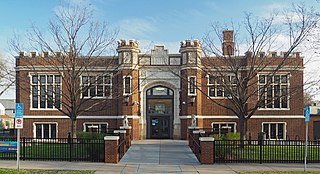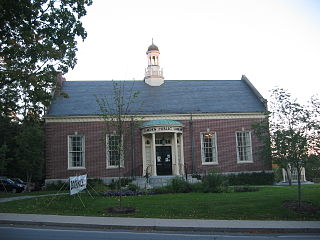The National Register of Historic Places (NRHP) is the United States federal government's official list of districts, sites, buildings, structures, and objects deemed worthy of preservation for their historical significance or "great artistic value". A property listed in the National Register, or located within a National Register Historic District, may qualify for tax incentives derived from the total value of expenses incurred in preserving the property.

The University of Maine (UMaine) is a public land-grant research university in Orono, Maine. It was established in 1865 as the land-grant college of Maine and is the flagship university of the University of Maine System. It is classified among "R1: Doctoral Universities – Very high research activity".

The Texas Historical Commission is an agency dedicated to historic preservation within the U.S. state of Texas. It administers the National Register of Historic Places for sites in Texas.

Haystack Mountain School of Crafts, commonly called "Haystack," is a craft school located at 89 Haystack School Drive on the coast of Deer Isle, Maine.

The Lewiston Public Library is a historic public Carnegie library at Park and Pine Street in Lewiston, Maine.

The Provo City Library is a public library serving residents of Provo and Orem in the U.S. state of Utah. It occupies the building of the former Brigham Young Academy, which was built in 1892. In 1976, the building was added to the National Register of Historic Places. After a remodeling process, it was rededicated as the Provo City Library on September 8, 2001.

Hosmer Library, originally known as the Thirty-Sixth Street Branch Library, is a branch library of the Hennepin County Library system serving the Central neighborhood of Minneapolis, Minnesota, United States. It was named the Hosmer Library in honor of James Kendall Hosmer and was listed on the National Register of Historic Places in 2000.

The Carnegie Free Library of Allegheny is situated in the Allegheny Center neighborhood of Pittsburgh, Pennsylvania. It was commissioned in 1886, the first Carnegie library to be commissioned in the United States. Donated to the public by entrepreneur Andrew Carnegie, it was built from 1886 to 1890 on a design by John L. Smithmeyer and Paul J. Pelz.

The Carnegie Library is a historic Carnegie library located at Muncie, Indiana, United States. The building houses the Local History & Genealogy collection and an open computer lab. The facility also provides wireless access and a meeting room for local groups to reserve. It is one of four branches that make up the Muncie Public Library System. The building was made possible through a financial donation to the City of Muncie by Andrew Carnegie to expand their library system throughout the community. The foundation for Carnegie Library was built in 1902 and the building opened to the public in 1904. It has been in continuous use as a library since its opening. The building is located in downtown Muncie at the intersection of Jackson and Jefferson.

The Carnegie Museum of the Keweenaw in Houghton, Michigan, is a non-collecting museum that houses changing exhibits about local cultural and natural history.

The Camden Public Library is the public library serving Camden, Maine, United States. It is a National Historic Landmark and is listed on the National Register of Historic Places.

The Smith County Historical Society, housed in the Carnegie Library, is located at 125 S. College Street in the city of Tyler, Smith County, Texas, U.S. It was built in 1904 as the Carnegie Public Library, and added to the National Register of Historic Places listings in Smith County, Texas in 1979. When Tyler built a new public library, the Carnegie building was leased to the Smith County Historical Society and continues to operate as a museum and archives.

The Bozeman Carnegie Library in Bozeman, Montana was built in 1903–1904 with funding from Andrew Carnegie. City librarian Bell Chrisman led the effort to convince the city to seek Carnegie funds. It is one of 17 libraries in Montana and 1,679 in the United States funded by Carnegie. It was built on a Greek Cross plan in Classical Revival style, with Roman Doric columns supporting a triangular pediment at its entrance. The library was listed on the National Register of Historic Places on February 2, 1979. Today, the building houses the law offices of Cok Kinzler, PLLP.

The Carnegie Library is a historic building on the Fisk University campus in Nashville, Tennessee. The cornerstone was laid in 1908 by William Howard Taft, who was then the U.S. Secretary of War. It was funded by Andrew Carnegie, who provided a number of academic libraries, as well as many public Carnegie libraries.

The Rumford Public Library is a library in Rumford, Maine. The building it is in was designed by Maine architect John Calvin Stevens and was built with a funding grant from Andrew Carnegie in 1903. The architecturally distinguished building was listed on the National Register of Historic Places in 1989.

Union City Public Library is a historic Carnegie library building located at Union City, Randolph County, Indiana. A grant request application was sent to Andrew Carnegie in the Fall of 1903, announcement for the approval of the grant was received in Union City in early December 1903, construction bids were taken in early 1904, ground was broken and foundation construction was started in early June 1904, and the building was completed and the library's collection installed in May, 1905, in time for a public grand opening and celebration held on June 8, 1905. The structure, of which the final design was approved by Carnegie, is a Classical Revival style Indiana limestone building with an upper main floor, and a former basement storage area which has been converted over for a youth services library and programing. Its design features a wooden pediment supported by four Corinthian order limestone columns and a wood balustrade. Its construction was funded by a $10,000 grant from the Carnegie Foundation.

Indianapolis Public Library Branch No. 3, also known as East Washington Branch Library, is a historic Carnegie library located in Indianapolis, Indiana. It was built between 1909 and 1911, and is a one-story, rectangular, Tudor Revival style dark red brick building on a raised basement. It has a truncated hipped roof behind a castellated parapet, and features terra cotta details and two hooded monk sculptures by Alexander Sangernebo. It was one of five libraries constructed from the $120,000 the Carnegie Foundation gave the city of Indianapolis in 1909 to be used towards the construction of six branch libraries. The other buildings include the Indianapolis Public Branch Library No. 6 and the Hawthorne Branch Library No. 2. A full renovation of the library was carried out in 1978 at a cost of $200,000. During a 2003 renovation, the interior was recarpeted and the metal entry doors, which were put in during the 1978 renovation, were replaced with custom oak doors modeled after the original doors. Indianapolis Public Library Branch No. 3 retains a high level of architectural integrity and continues to serve the community in its original role. The library remains in operation as the East Washington Branch of the Indianapolis Public Library.



















